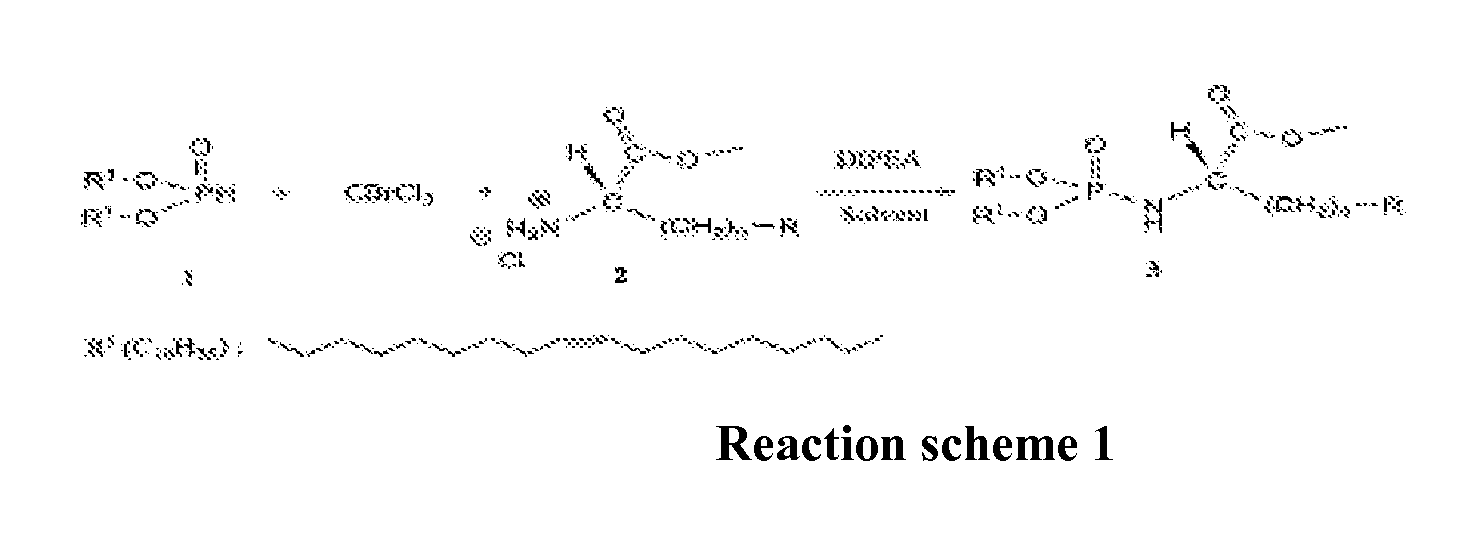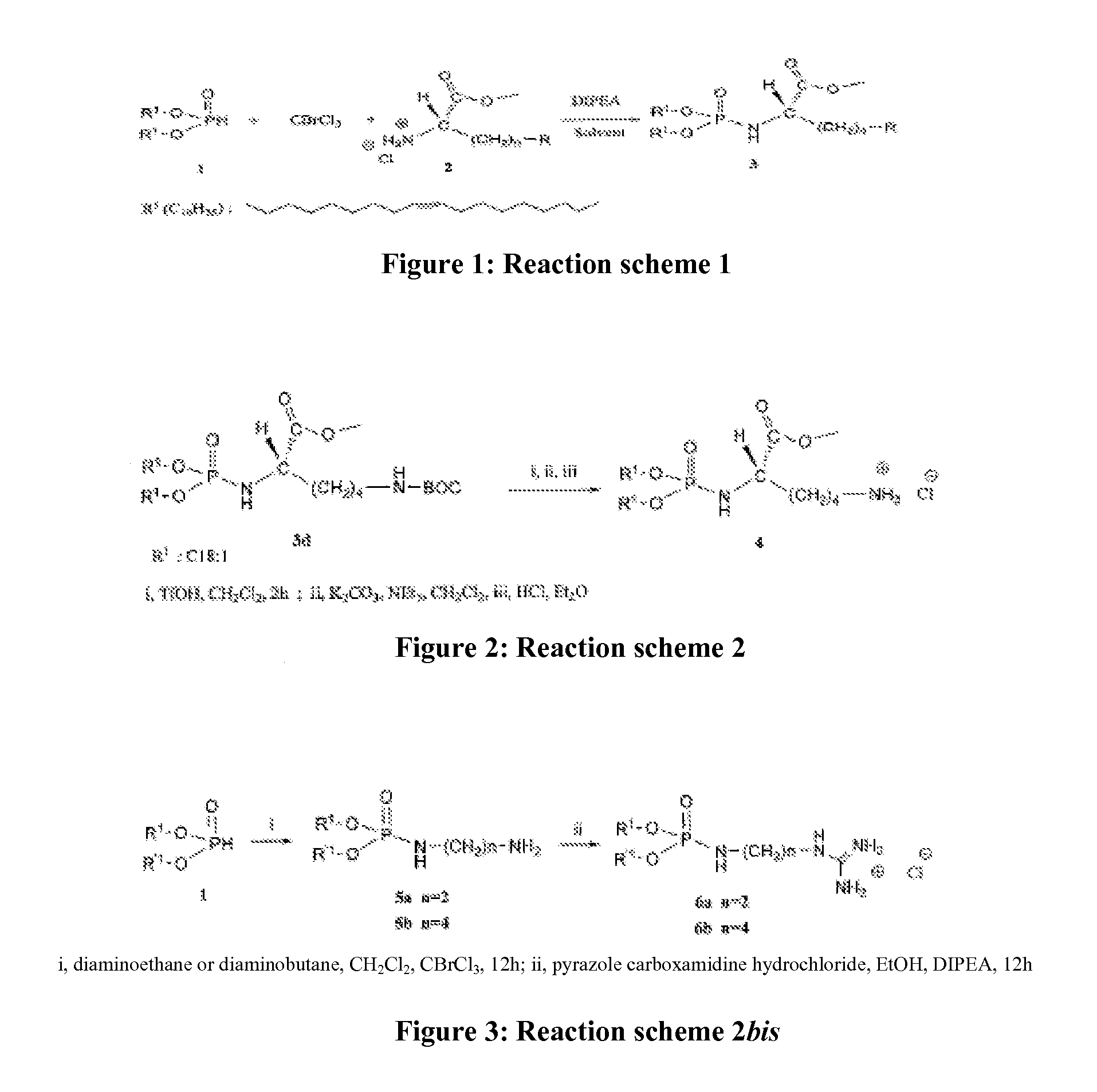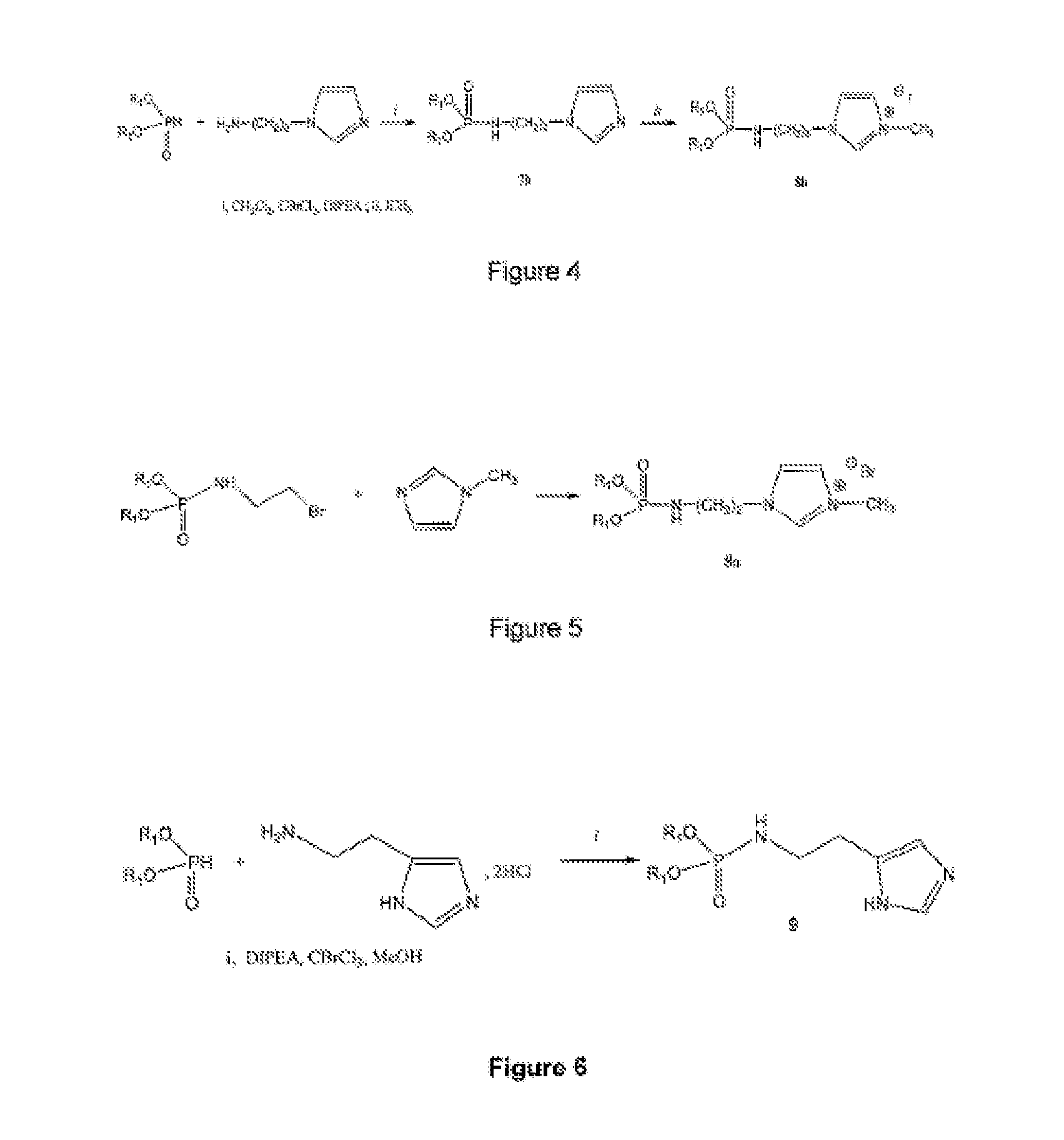Novel lipophilic compositions and uses thereof
a composition and composition technology, applied in the field of lipophilic compositions, can solve the problems of reducing the cytotoxic properties of some cationic lipophilic vectors, poor cell dna transfection efficiency of non-viral cationic lipophilic vectors,
- Summary
- Abstract
- Description
- Claims
- Application Information
AI Technical Summary
Problems solved by technology
Method used
Image
Examples
example 1
Synthesis of a Dioleoyl Phosphoramidate Compound Derived from Histidine Methyl Ester
[0254]2.91 g of dioleylphosphite (5 mmol), 920.35 mg of histidine methyl ester dihydrochloride (5 mmol), 15 mL of MeOH and 550 μL of CBrCl3 (5.5 mmol) are combined together. The mixture is placed at a temperature lower than 5° C. in an ice / acetone bath. 2.6 mL of DIPEA (15 mmol) are then added thereto and the mixture is stirred at this temperature for one hour, then for one night at room temperature.
[0255]A purification through a silica gel column chromatography with for elution a mixture of CHCl3 / MeOH (90 / 10) enables the isolation of a pale yellow oil with a yield of 29% (m=1.08 g).
[0256]The structure of the compound is controlled with a proton, phosphorus-31 and carbon-13 NMR, and a mass spectrometry:
1H-NMR in ppm (CDCl3)
[0257]0.86 (t, 6H, CH3, 3JH-H=6.6 Hz); 1.26 (m, 44H, CH2); 1.65 (m, 4H, CH2 —O); 1.99 (m, 8H, CH2 α-CH═CH); 3.08 (d, 2H, CH2Im, 3JH-H=5.3 Hz); 3.71 (s, 3H, OCH3); 3.80 (t, NH, 10 H...
example 5
Synthesis of 3-propylmethylimidazolium dioleoyl phosphoramidate iodide
[0284]2.91 g of dioleylphosphite (5 mmol), 590 μL of aminopropyl imidazole (5 mmol), 15 mL of CH2Cl2 and 550 μL of CBrCl3 (5.5 mmol) are combined together while maintaining the temperature at less than 5° C. in an ice / acetone bath. 960 μL of DIPEA (5.5 mmol) are then added thereto and the mixture is stirred at this temperature for one hour, thereafter for one hour at room temperature.
[0285]After evaporation of the solvents, the mixture is taken up with ether and DIPEA precipitated salts are removed by filtration.
[0286]After purification on silica gel (eluent CHCl3 / MeOH (90 / 10)), the phosphoramidate is obtained with a 82% yield as a pale yellow oil.
[0287]The structure of the intermediate compound is controlled with a proton, phosphorus-31 and carbon-13 NMR, thereafter quaternization is effected as follows:
[0288]2.8 g of the compound 5 (4 mmol) are solubilized in a large excess of ICH3 (3 mL) and the mixture is sti...
example 6
Synthesis of a Dioleoyl Phosphoramidate Compound Derived from Histamine
[0294]2.91 g of dioleylphosphite (5 mmol), 920.3 mg of histamine dihydrochloride (5 mmol), 15 mL of MeOH and 550 μL of CBrCL3 (5.5 mmol) are combined together. The mixture is placed at a temperature lower than 5° C. in an ice / acetone bath. 2.6 mL of DIPEA (15 mmol) are then added thereto and the mixture is stirred at this temperature for one hour, then for one night at room temperature.
[0295]A purification through a silica gel column chromatography with for elution a mixture of CHCl3 / MeOH (90 / 10) enables the isolation of a pale yellow oil with a yield of 30%.
[0296]The structure of the compound is controlled with a proton, phosphorus-31 and carbon-13 NMR, and a mass spectrometry:
1H-NMR in ppm (CDCl3):
[0297]0.86 (t, 6H, CH3, 3JH-H=6.6 Hz); 1.26 (m, 44H, CH2); 1.65 (m, 4H, CH2 —O); 1.99 (m, 8H, CH2 —CH═CH); 2.79 (t, 2H, CH2Im, 3JH-H=5.5 Hz); 3.13 (m, NH) 3.19 (m, 2H, CH2(NH)); 3.98 (m, 4H, CH2 α-O, 3JH-H=3JP-H=6.4 H...
PUM
| Property | Measurement | Unit |
|---|---|---|
| Composition | aaaaa | aaaaa |
| Lipophilicity | aaaaa | aaaaa |
Abstract
Description
Claims
Application Information
 Login to View More
Login to View More - R&D
- Intellectual Property
- Life Sciences
- Materials
- Tech Scout
- Unparalleled Data Quality
- Higher Quality Content
- 60% Fewer Hallucinations
Browse by: Latest US Patents, China's latest patents, Technical Efficacy Thesaurus, Application Domain, Technology Topic, Popular Technical Reports.
© 2025 PatSnap. All rights reserved.Legal|Privacy policy|Modern Slavery Act Transparency Statement|Sitemap|About US| Contact US: help@patsnap.com



